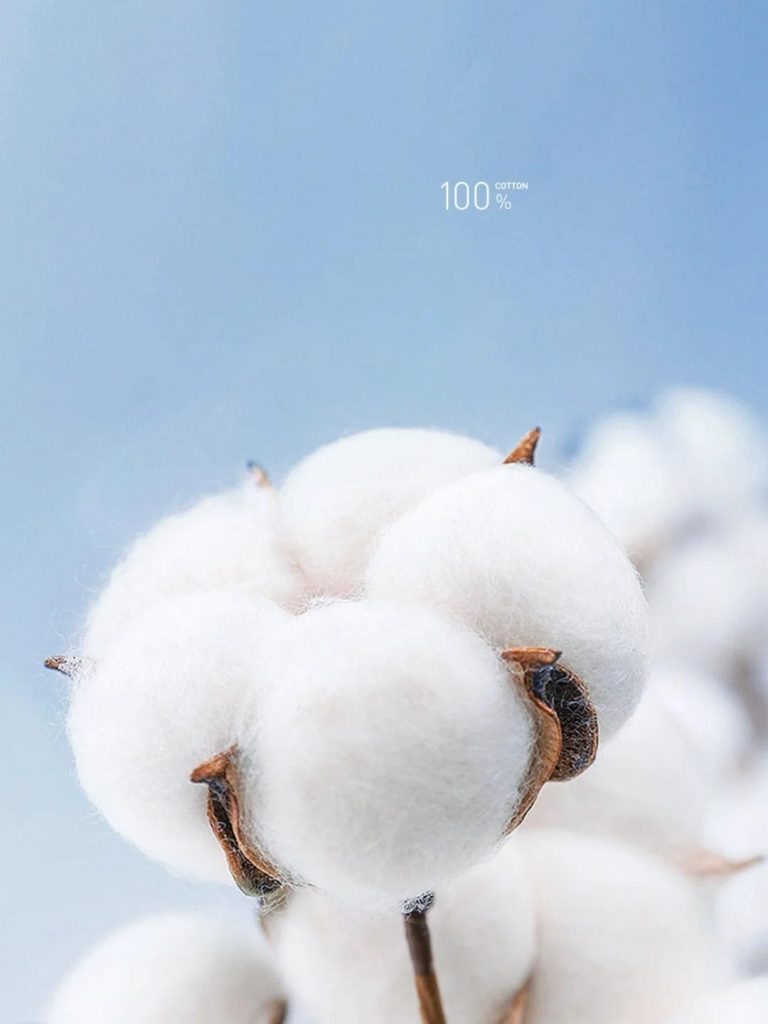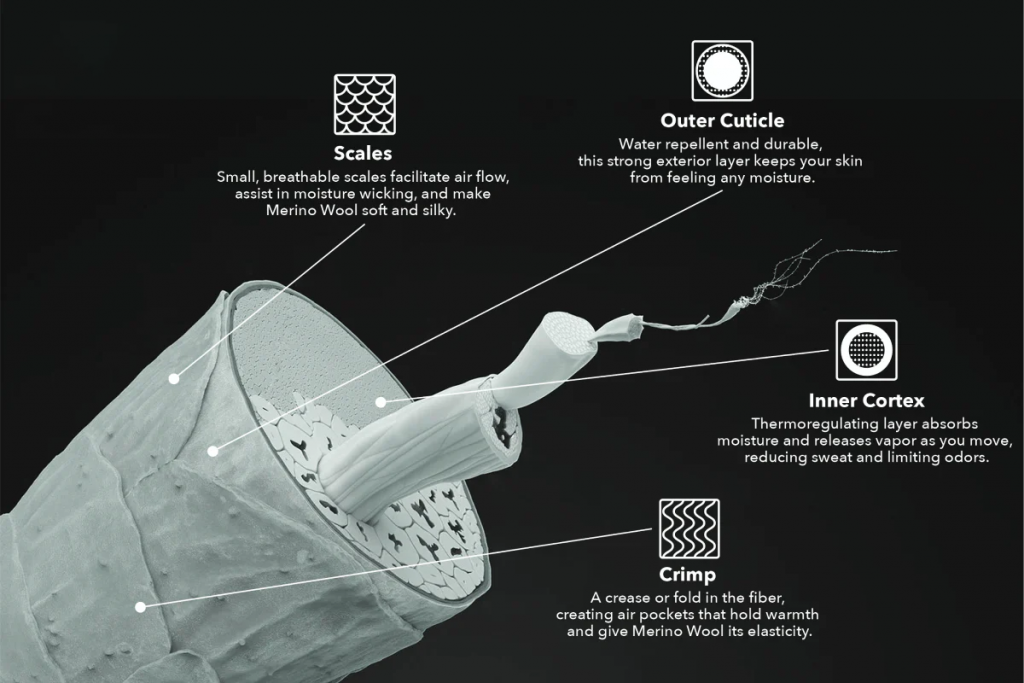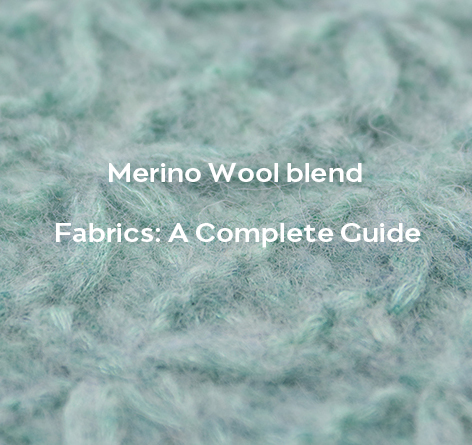When planning a trip, choosing the appropriate clothing isn’t solely based on fashion, it also directly affects comfort, packing efficiency, and sustainability. The fabric’s choice affects the ease of packing light, the behavior of your clothes in different climates, and the comfort of your clothes after a few uses. For travelers, the most common fabric opponents are Merino wool and cotton, each having their own benefits. But which fabric is more beneficial to your travel?
In this article, we’ll assess the similarities and differences between these two materials in regards to their capabilities to odors, their durability, their environmental performance, their sustainability, and their cost, all of which will help you to make the best decision. Whether you’re walking through the mountains or exploring the urban areas, choosing the appropriate fabric will ensure that your clothing is appropriate for you, not the other way around.
Ⅰ. Key Differences Between Merino Wool and Cotton
Merino wool and cotton are both popular natural fibers, their properties differ significantly, which affects their performance as clothing for travel. Both substances are derived from environmentally friendly sources—wool is derived from the flannel of Merino sheep’s wool, while cotton is derived from the seed fibers of their cotton plants. However, their inherent properties make them appropriate for different purposes.
Merino’s wool is notable for its temperature regulation, which will help you to remain warm in cold weather and cool in hot weather. It is adept at moisture-wicking and quickly dries, which enables travelers to be comfortable during their active pursuits. Additionally, merino wool is inherently anti-odor, even after multiple uses, this is significant for trips that have limited amounts of laundry that can be done.
Conversely, cotton has a reputation for providing superior softness and breathability, it is popular for casual clothing and warm climates. While it’s beneficial, it typically retains moisture and contains sweat, which can lead to discomfort in humid or cold environments. Also, cotton is susceptible to wrinkling and requires more frequent cleaning, this is because it is more likely to trap odors than wool.
When designing a travel Wardrobe, understanding the aforementioned traits is crucial to travelers in making more informed decisions. For travel that is active or erratic, Merino’s performance-based attributes are beneficial. For brief, low-paying jobs or short vacations, cotton is an affordable, comfortable option. Both fabrics have benefits in different situations, but understanding their properties and limitations will help you to carry light and remain comfortable wherever you travel.
Ⅱ. Breathability and Moisture-Wicking Capabilities

When it comes to travel clothing, the capacity to breathe and the moisture-wicking properties are important in regards to maintaining comfort in different climates. Understanding the different fabrics’ abilities to regulate sweat and moisture can have a significant impact on your travel experience, particularly in hot or humid environments.
Merino Wool
Merino wool is well-known for its exceptional capacity to absorb moisture. This natural fiber promotes the evaporation of sweat from the skin, allowing the skin to remain dry and comfortable during travel. The composition of Merino fiber’s structure creates small pockets that trap air, this is beneficial for breathability while also allowing moisture to escape.
One of the most notable properties of Merino wool is its capacity to maintain its insulating properties when wet. This is of paramount importance in erratic weather, where precipitation or sweat can lead to a feeling of coldness. Unlike synthetic fibers, which can lose their thermal capacity when wet, merino wool continues to provide insulation, making it an ideal choice for outdoor activities and climates that vary. Merino wool promotes the regulation of body temperature. It maintains your temperature at a neutral level, either hot or cold, which is beneficial to travelers who may be shifting between different environments during the day. This temperature regulation, combined with its moisture-wicking abilities, grants merino wool a prestigious position in the best fabric categories for the hot season.
Cotton
Cotton is a popular fabric that is appreciated for its softness and breathability. When the temperatures increase, cotton clothing is comfortable against the skin, and its breathability allows for airflow. However, the way cotton is moisture-managed is lacking. Unlike Merino wool, cotton is responsible for storing sweat instead of removing it. This trait can result in damp clothing, particularly in humid climates.
While cotton is appropriate for short durations of travel or warm, dry conditions, it can become frustrating during extended wear or intense activity. Once the cotton is damp, it retains water and will take a long time to dry, this may lead to travelers having a sensation of being clammy or chilled. In environments with humidity, this moisture retention can lead to increased discomfort and chafing, this is not ideal for daily wear.
Overall, if you’re in search of breathable clothing that is exceptional in controlling moisture and sweat, Merino wool is the most appropriate. Its singular properties facilitate the dry and comfortable, while also providing insulation in erratic weather. Conversely, while cotton may seem beneficial in dry environments, its tendency to soak up moisture makes it less ideal for humid climates or situations that require long-term wear.
Ⅲ. Odor Control and Re-Wearability

When considering how to pack for travel, one of the most important factors is how your clothing will evolve over time, specifically when there is not a readily available laundry facility. Controlling odors and reusability are both important in order to remain fresh and enjoyable on the road.
Merino Wool
Merino’s wool is inherently odor-resistant, this is attributed to the unique composition of its fiber and the natural properties they possess. The wool’s fibers contain keratin, which promotes the prevention of the accumulation of bacteria that produce odors. This trait makes Merino wool ideal for long trips, the facilities for washing are likely to be limited.
Travelers often wear Merino wool clothing that is multiple times before it needs to be washed. Many users claim that they can wear Merino wool for over a day without any significant odor, this makes it a popular option for long trips and adventures. This attribute not only promotes hygienic travel but also diminishes the number of items of clothing necessary to bring, which will lead to more efficient packing.
Cotton
However, cotton lacks the same odor-resisting capabilities as Merino wool. While cotton is supple and breathable, it typically absorbs sweat and odors more rapidly, as a result, it is more frequently washed. Once cotton clothing becomes damp, it can retain moisture and smells, which will lead to having to wash it.
For those who travel, this implies that cotton clothing may need to be frequently washed, which is both inconvenient and time-consuming, especially on longer trips. In environments that have limited access to laundry, if people rely on cotton, it will lead to discomfort and hygienic concerns.
Overall, for those who prioritize odor control and the ability to re-wear their travel gear, Merino wool is the clear victor. Its instinctual capacity to prevent odor accumulation allows travelers to carry less luggage and enjoy longer stretches between stops. Conversely, while cotton is beneficial, its tendency to soak up moisture and odors makes it less ideal for trips that lack a laundromat.
Ⅳ. Fabric Durability: Which Lasts Longer for Travel Use?

When selecting clothing that is intended for travel, the durability of the fabric is of paramount importance, as you want your clothing to be able to withstand the harshness of travel and frequent use. Understanding the different fabrics’ capabilities over time can assist you in making informed decisions regarding your travel attire.
Merino Wool
Merino’s wool is renowned for its capacity to maintain form and structure after multiple washes.
Its inherent flexibility allows it to regrow back after being stretched; this is a durable option for travelers. While Merino wool clothing may have a tendency to pilling, the formation of small fuzzballs on the surface is not significant in regards to their overall longevity or capabilities.
With proper maintenance, merino wool can maintain its original size and shape, even after being repeatedly washed. This is a popular choice for travelers who want clothing that will be able to last throughout their travesies. HD MERINO COLLECTION is our new Merino wool collection that is shrink-proof and machine washable, ensuring you can enjoy its benefits without requiring special care. Additionally, many brands specialize in providing Merino wool blends, such as those combined with nylon, which will enhance the fabric’s durability while still maintaining the fabric’s beneficial properties. These combinations can mitigate the effects of pilling and increase the overall longevity of travel clothing.
Cotton
Cotton is a common fabric for everyday use because of its comfort and breathability. However, it may be less long-lasting than Merino wool in regards to long-term usage. One of the primary concerns associated with cotton is its propensity to decrease in size over time, this is particularly true if the cotton is exposed to high temperatures during washing or drying. This decrease in size can adversely affect the quality and comfort of cotton clothing, leading to a shorter overall lifespan.
Additionally, frequent cleaning can lead to cotton becoming more susceptible to degradation than wool. While cotton is simple to maintain, repeated exposure to water and cleaning agents can adversely affect its fibers, which results in wear and tear. This diminishes cotton’s popularity as a clothing material for travelers who want long-lasting clothing that can withstand the demands of activewear.
Overall, the fabric made from merino sheep has a longer lifespan and retains its shape more effectively than cotton.
Ⅴ. Weather Performance: Hot and Cold Climate Travel
When traversing different climates, the capacity of your clothing to adapt to temperature changes can have a significant impact on your enjoyment. Understanding the different fabrics’ capabilities in both hot and cold conditions is crucial to any voyageurs.
Merino Wool
Merino wool is celebrated for its exceptional ability to regulate temperature, which makes it ideal for a variety of climates. This natural fiber can effectively pull moisture from the skin, which allows the body to cool down during humid weather. The peculiar composition of Merino fiber promotes airflow, which allows you to remain comfortable without overheating.
In temperate climates that have cold seasons, Merino wool has a superior insulation capacity. Even when damp, it retains its insulating properties, which causes you to remain warm and comfortable. This attribute is particularly beneficial to travelers who may have to deal with unexpected precipitation or snowfall. Additionally, merino wool possesses natural ultraviolet protection, which makes it an ideal choice for destinations that have a lot of sun, as it can shield the skin from harmful rays while still providing a cooling effect.
Cotton

Cotton is both soft and inviting, but it lacks weather ability regarding its capabilities. It is exceptional in dry, hot conditions, providing a breathable option that feels good against the skin. However, the cotton’s moisture retention capacity can cause distress in humid or wet environments. Once cotton is damp, it can feel heavy and adhering, this makes it less conducive to activities that involve sweating or exposure to rain.
In cold or flooded conditions, cotton provides little to no insulation. When it’s wet, it loses its capacity to keep you warm, which can lead to discomfort and chilliness. This lack of thermal efficiency causes cotton to be an unsuccessful choice for travelers who seek dependable clothing that performs well in erratic weather.
Ⅵ. Ease of Packing: Wrinkle Resistance and Space Efficiency

When traveling, organizing efficiently can have a significant impact on your overall experience, this is particularly true of those who travel with carry-on luggage or who have a minimalist approach to traveling. Two critical factors that affect the ease of packing are wrinkle resistance and efficiency in space.
Merino Wool
One of the most notable attributes of merino wool is its wrinkle resistance. Unlike other fabrics, Merino wool is able to be folded and compacted without exhibiting any creases. This attribute makes it an ideal choice for travelers who want to appear polished without the inconvenience of ironing or steaming clothing upon arrival. Additionally, Merino wool clothing is typically lightweight and compresses well, which allows you to maximize the volume of luggage you have. This compact nature is beneficial to both carry-on travelers and minimalist packers who want to minimize the number of items they transport.
Additionally, the natural flexibility of Merino wool promotes the garments’ restoration to their original shape, which further enhances their travelability. This implies that, after traveling for a long period of time or spending a day in a haphazardly organized backpack, your Merino clothing still probably shows up with a fresh, pretty look.
Cotton
While cotton is a common fabric and enjoyable to wear, it is not well suited for resistance to wrinkles. Cotton clothing typically folds easily, this requires more attention during packing and may necessitate the need to iron before wearing. This can be particularly problematic for travelers who have limited time or resources available to care for their clothing upon arrival.
Additionally, cotton clothing has a higher potential for taking up space in your suitcase than Merino wool. Heavier cotton fabric may not have the same capacity to compress, this means that you may have to sacrifice space for additional layers when packing. This can be of concern to travelers who want to pack everything into a carry-on or those who want to minimize their packing.
Ⅶ. Sustainability and Environmental Impact

As consumers become more aware of their preferences, the sustainability and environmental impact of fabric is increasing in importance in the clothing decision.
Merino Wool
Merino wool is a renewable resource that has multiple environmental benefits. One of its distinguishing features is its biodegradability; when discarded, Merino wool naturally decomposes without leaving any harmful byproducts, which enriches the soil in the process. Additionally, many Merino wool products are environmentally friendly, as many brands advocate for sustainable farming that focuses on animal welfare and environmental conservation.
Another important aspect of the sustainability of Merino wool is its long life. Wool clothing is associated with its long life and can be superior to other synthetic alternatives in terms of longevity. This longevity decreases the necessity of frequent updates, thus decreasing the amount of clothing waste that is landfilled. Additionally, the carbon footprint associated with the production of wool is typically lower than that of conventional cotton, the former requires less water and less chemicals in its processing.
Organic Cotton
Organic cotton is a viable and sustainable alternative to conventional cotton production, this production involves a lower volume of pesticides and less water consumption. Organic farming eschews harmful chemicals in favor of healthier ecosystems and superior soil quality. Additionally, organic cotton farming typically utilizes crop rotation and natural fertilizers, these components help to maintain biodiversity and soil fertility.
While organic cotton is more environmentally friendly than conventional cotton, it still lacks the environmental friendliness of Merino wool in certain areas. Even when grown naturally, cotton has a larger carbon footprint than wool because of its greater need for water and the energy involved in processing and transportation.
Ⅷ. Price Comparison: Value for Travelers
When shopping for travel clothing, the price of the fabric is important to consider, this affects the initial purchase as well as the long-term value of the fabric.
Merino Wool
Merino wool is typically associated with a higher initial cost than cotton is. This expense is primarily caused by the quality of the fiber and the consistent farming methods employed in its creation. For instance, a high-end Merino wool top can cost between $80 and $150, depending on the brand and special features. However, the initial cost may be high, but merino wool has a significant value associated with its longevity and re-wearability.
Travelers who buy merino wool typically have the ability to wear these garments multiple times between washes because of their natural odor-resisting capabilities. This implies that fewer items of clothing are necessary for a journey, which leads to a lighter load of laundry and less hassle. Additionally, the long lifespan of Merino wool contributes to a longer lifespan, which reduces the need for frequent updates. This longevity is reflected in long-term savings, which makes the Merino wool a popular choice for travelers who want quality and performance.
Cotton
Cotton is typically more budget-friendly, with basic cotton shirts and pants that are available for $20-50. This lower price point is beneficial to cotton, which is an option that attracts travelers on a budget. The initial expenditure is attractive, but cotton may not provide the same long-term value as Merino wool.
Because of its propensity to soak up moisture and smells, cotton clothing is typically required to be washed more frequently, which can lead to a faster rate of wear and tear. Travelers may have to replace their cotton clothing more frequently, which will ultimately lead to an increase in the total expenditure over time. Additionally, when cotton clothing is wet, it can feel heavy and uncomfortable, which can lead to a need for additional items in a travel Wardrobe to maintain comfort.
Ⅸ. Caring for Merino Wool and Cotton During Travel

The proper treatment of your travel clothing can greatly extend its life and maintain its appearance, this is an important consideration for intelligent travelers.
Taking Care of Merino Wool
Merino wool is associated with its low maintenance requirements, this is why it’s popular among travelers. Here is a list of important tips:
- Washing Wool:
It’s typically machine-washable, but you should follow the manufacturer’s recommendations. Many of Merino’s wool clothing can be submerged in warm water on a delicate cycle. For the most effective care, consider using a specialized detergent for wool, this will preserve the fibers.
- Air-drying:
After cleaning, it’s recommended to air-dry. Allow the garment to rest on a clean towel or a drying rack in order to maintain its original shape. Avoid hanging Merino wool as it can lead to stretching.
- Re-Wearing:
Because of its natural odor-resistant properties, merino wool can be re-used multiple times before requiring a wash, this is ideal for travel.
Taking Care of Cotton
Also, cotton is simple to maintain, but it has its own limitations:
- Washing Cotton:
Typically, cotton can sustain repeated washes, using cold water and a mild detergent can have a positive effect on the wear. Avoid fabric softeners, as they can negatively affect the cotton’s ability to breathe.
- Wrinkle resistance:
Cotton is typically wrinkled easily, this is especially true when the fabric is packed closely. To address this, consider using a wrinkle spray or storing your cotton clothing in a way that minimizes folding. Also, rolling the cotton items instead of folding them can also contribute to reducing wrinkles.
- Frequent Cleaning:
Contrasting with Merino wool, cotton is more susceptible to cleaning frequency because of its tendency to absorb odors and moisture. Attempt to maintain the hygiene of cotton items on a regular basis, especially in hot climates or during intense activity.
Travel-Friendly Laundry Advices
For both fabric types, there are several practical travel strategies that simplify the care of the laundry:
- Quick-Wash Merino T-Shirts:
Look for quick-drying Merino wool T-shirts that are designed to dry more quickly than traditional wool. This attribute enables you to wash them while on the go without concern over long drying periods.
- Portable Laundry Solution:
Consider bringing a sink stopper and a small bottle of travel detergent with you to wash items in the hotel’s sink. This facilitates quick washes, especially for Merino wool, which is often air-dried for a night.
- Use The Wrinkle Release Spray:
Keep a travel-sized version of the spray in your bag to quickly replenish the cotton fabric of clothing after being packed. A few spritzes can facilitate the removal of wrinkles, allowing you to appear shiny without the difficulty of ironing.
Ⅹ. Best Use Cases: When to Wear Merino Wool vs. Cotton on the Road

Selecting the appropriate fabric for your travel adventures can enhance your experience, providing both comfort and practicality during your trip. Below, we discuss specific scenarios in which merino wool and cotton are successful, which will help you decide how to arrange travel clothing.
-
Multi-Day Hikes
For activities that last over a day, like hiking or backpacking, Merino wool is the ideal choice. Its humidity-wicking abilities help to keep you dry, while its odor-resisting nature allows you to wear it for several days without having to wash it. Merino wool clothing, such as base layers and mid-layers, have a superior insulation rating and regulate the temperature well, making them ideal for erratic weather.
-
Cold Weather Travel
When exposed to cold climates, Merino wool exhibits the characteristics of a fabric that is layered. It promotes warmth when in the wet state and regulates the body’s temperature effectively. A Merino wool base layer can be combined with insulating layers that will provide the most warmth during winter sports like skiing or snowboarding.
-
Unpredictable Weather Conditions
If you’re traveling to a region that has a lot of sudden weather changes, storing Merino wool is a smart choice. It adjusts to different temperatures and retains its insulation properties in wet conditions, which will keep you comfortable regardless of the weather’s conditions.
-
Casual Sightseeing in Warm, Dry Areas
Cotton is a wonderful choice for vacation days that are comfortable, and dry. Its flexibility and breathability facilitate strolling around cities or simply lounging on the beach. Lightweight cotton shirts and shorts are ideal for casual occasions where comfort is of paramount importance.
-
Everyday Activities
If your schedule has less physical activity than usual, cotton is a budget-friendly choice. It’s commonplace and can be altered for various situations, it’s therefore appropriate for casual dining or cultural encounters.
Conclusion
The discrepancy between merino wool and cotton is primarily based on your travel preferences and personal requirements. Merino’s wool is exceptional in its ability to absorb odors, have moisture-wicking properties, and have an odor resistance.
and temperature regulation, making it ideal for active travelers, naturalists, and environmentalists. While it may initially cost more, its long-lasting nature and reusability can help to provide long-term savings and benefits. Conversely, cotton is still a popular choice for budget travelers who want to enjoy comfort during casual errands in warm, dry climates. However, its capacity to absorb moisture and its tendency to need to be frequently cleaned may diminish its effectiveness for long wear.
To make the best decision regarding your travel wardrobe, consider your schedule and the dangers you’ll face. For those who plan active adventures or encounter random weather, storing Merino wool can increase your comfort and versatility. Conversely, if your trip is characterized by leisurely strolling in pleasant locations, cotton can be an affordable option. Regardless of the fabric’s choice, understanding the benefits and drawbacks of each can significantly enhance your travel experience. For additional information, explore our articles on HD Merino and effective methods of packing.






